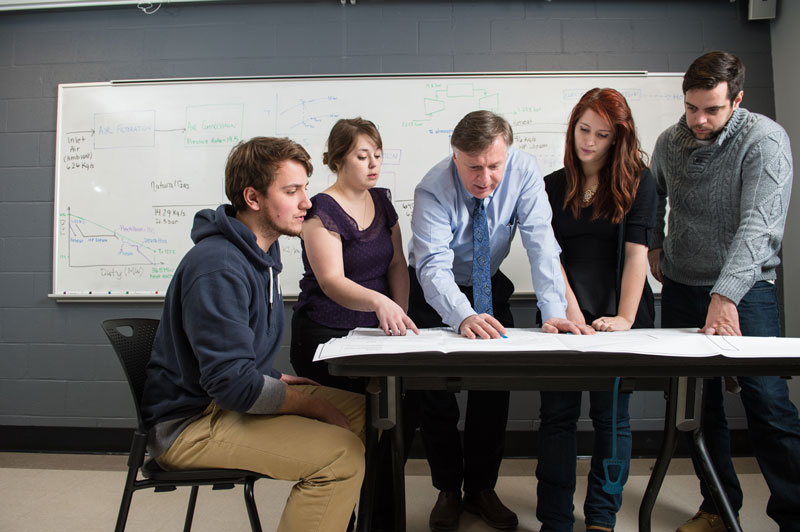The 8 Milestones in UNB’s Final-Year Student Capstone Design Course
Author: Engineering Alumni Office
Posted on Dec 6, 2018
Category: Student Spotlight
Think engineering school is all about classroom teaching and exams? Think again.
Students in their final year of UNB’s engineering program work year-round on a real-world design project from start to finish – projects that come from industry clients and that are supervised by industry mentors.
A number of years ago, Dr. Michel Couturier, the NSERC Chair for Collaborative Engineering Design Education at UNB, created a required year-long senior design project as a way to teach experientially so that graduates can immediately contribute when they’re hired.
“Students and faculty collaborate with local industry clients as well as professional engineers who act as mentors and supervisors to come up with real solutions to real industry needs,” he says. “By having outside clients sponsor our senior design projects and by having practicing and retired design engineers as mentors for our students, we are producing engineering graduates with greater confidence in their abilities while helping local companies obtain innovative design solutions.”
Every fourth-year student team presents their design to their client and to the public at the annual Design Symposium in April. They’re judged by their clients and marked by their industry and academic mentors.
So what, exactly, are they marked on?
While every disciplinary team is slightly different, all student teams work toward meeting tailored milestones throughout the year that are similar to the milestones they would take in the workplace.
Brad McPherson, P.Eng, (BScCHE’05) is an industry mentor who this year is working with two student teams - one all chemical engineering students and one which is multidisciplinary (both chemical and mechanical students). He shares the 8 milestones his student teams - who are working on chemical processes - are required to hit:
- A backgrounder of the project and set the limits for the problem and design.
- A technical literature search to understand the scope of knowledge around issues and best industry practices.
- A base-case design with preliminary thoughts around a design solution, which is presented to the client and adjustments made based on feedback.
- A PFD (process flow diagram) and mass balances report.
- An analysis of energy balances of physical and reaction energy (ie. how much energy did it take to do what I need to do?).
- A sizing and costing analysis to properly evaluate the sizing and time needed for the design.
- A feasibility, economic, and sensitivity analysis that gets more detailed into the true costs, production capacity, market potential, payoff period, acceptable rate of return, and factors that will impact the project viability overall, etc.
- The final report and presentation at the Design Symposium. Student teams present the full project design and recommendations to the client and industry judges.
McPherson says these milestones (which are specific to process design) are mostly the same steps taken in industry, and they give students a much better understanding of what it takes to be successful in the real world. “There are a lot of life lessons in this course,” he says. “In reality, many projects that go through this process don’t work out, or you just don’t get the green light. But it’s never a waste of time if you put this kind of dedicated work into it. It informs organizations moving forward.”
He also believes that this experiential way of teaching is hugely beneficial for employers as well. “Not only do they get design work done, they get to basically interview students for a whole year and sell their company and culture to them. Students can often get hired by their client company after they graduate – and these students can be productive very quickly because they already know the company well.”
To learn more about becoming a mentor for fourth-year engineering students at UNB or to have your company become an industry client, see details on the website, and email Dr. Couturier. Mentors can live anywhere across Canada and meet with students via online video connection.
And be sure to come out and see students' final design projects at the Annual Design Symposium in Fredericton!
